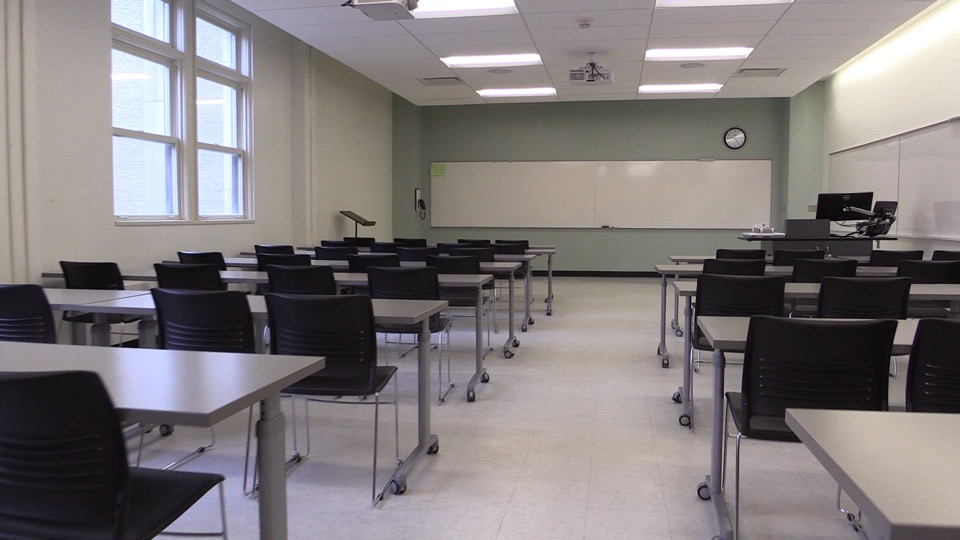As an institution, we design learning spaces and select learning technologies, and implement them in ways to make them available to enable and enhance student learning. But, the design decisions made in the development, selection, and implementation of these resources shape what is perceived to be possible. The resources may not be technically restrictive to specific usage patterns and pedagogies, but through design decisions there are paths of least resistance that will naturally be found.
We become what we behold. We shape our tools, and thereafter our tools shape us.
-Marshall Mcluhan
Rooms will tend to have a natural “front” and “back” if there is a large projection screen on one wall. Even if flexible and mobile classroom furniture is provided, the common usage pattern will be rows facing the front.
Physical structures themselves can be seen as artifacts that communicate nonverbally.
-Strange & Banning, 20011

Even though tables are on wheels, and chairs are movable, they gravitate toward the natural “front” of the room. In the photo above, there is actually another large screen along the right wall (opposite the windows) with an independent projector. But it’s largely ignored, and chairs might as well be bolted to the floor in this configuration.

Another room, in the same building, designed without a “front”, and with highly movable and individual furniture. The room looks different every time I see it. There is a projector, but it’s on a cart, because it needs to point someplace different each time it’s used. Even the pillar in the middle of the room gets used as a natural way to divide the room into quarters, without needing walls or barriers.
Rooms typically have a front because it’s easiest to do it that way. It’s easier to set up. It’s easier to reset between sessions. It’s easier to clean. It’s easier to maintain. Many of those reasons aren’t learning-focused, so we wind up with institutional and historical paths-of-least-resistance defining how spaces will be used. But it doesn’t need to be that way. The JISC InfoNet Learning Spaces website contains a wealth of resources that provide suggestions and provocations to design spaces to be learner- and learning-centric.
Learning science indicates that successful learning is often active, social, and learner-centered. However, with the multiple responsibilities of faculty, staff, and administrators, as well as the large numbers of students most campuses serve, ensuring successful learning without the support of IT may be impossible. Individualization and customization are laudable goals for instruction; they are also time intensive. With the appropriate use of technology, learning can be made more active, social, and learner centered — but the uses of IT are driven by pedagogy, not technology.
– Oblinger & Oblinger, 20052
Basic decisions, like “where is the screen, and how big is it?” define what the room will be used for (no matter what the stated goal of flexibility might be). Basic technology like “have whiteboards everywhere” makes the room useful and flexible. Having seats not bolted together, or spread around tables, makes the room inherently more reconfigurable – even if the tables are on wheels. Tables suggest a way to use them. It’s difficult to overcome those subtle suggestions.
Similar patterns exist in learning technologies – whether physical devices like projectors and screens and podiums (podia?) or software-based resources like learning management systems or student response systems or discussion boards.
Audrey Watters is working on a book on the history of teaching machines – Chapter 1, on “Programmed Instruction”, looks at how some intentional (and unintentional) design choices made during the early development of what is now called “educational technology” has saddled us with decades of baggage and historically adopted-and-forgotten-about decisions. Her recent article on the history of multiple choice testing machines uses the concrete example of multiple choice exams becoming hardcoded into optical scoring machines. Multiple choice tests typically have no more than 5 possible choices, because of the physical limitations of printing the sheets and on the optical scoring device on detecting student answers. And yet online exams still maintain a similar pattern despite not being limited by either printing or optical scanning.
What other historical and technological implementation details have framed the perceived possible uses of learning technologies? Why are discussions typically linear and threaded, rather than more network-based and organic? Why are learning management systems typically institution- and course-centric, rather than learner-centric?
More importantly, how can we critically analyze our designs and implementations to question these inherent historical-and-not-learner-centric patterns?
The mission of EDU in the new Taylor Institute for Teaching and Learning is to “build teaching and learning capacity by creating networks of practice, supporting technology integration, and promoting evidence-based approaches in order to enrich student learning experiences.” To do this, we will need to constantly critically reflect on what we are doing, on what instructors and students are doing, and how the decisions and actions shape the learning experience.
- Strange, C.C. & Banning, J.H. (2001). Educating by Design: Creating Campus Learning Environments that Work. John Wiley & Sons. San Francisco. [↩]
- Oblinger, D.G. & Oblinger, J.L. (2005). Is it Age or IT: First Steps Toward Understanding the Net Generation. In Educating the Net Generation. EDUCAUSE. Retrieved from https://net.educause.edu/ir/library/pdf/pub7101b.pdf [↩]
1 thought on “on learning spaces and technologies”
Comments are closed.